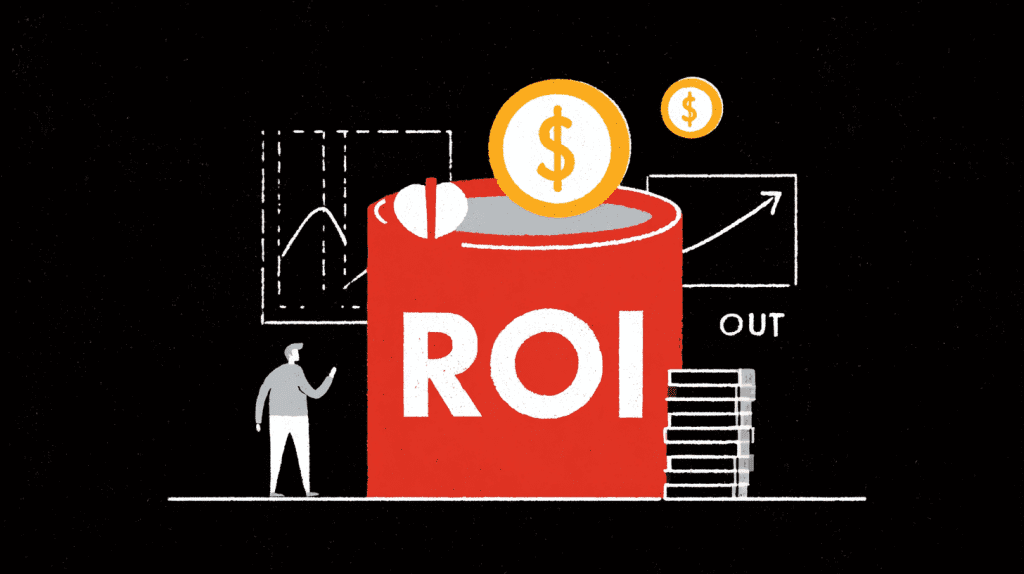Every financial decision comes down to one fundamental question: is this worth it? Whether you’re a business owner evaluating a new marketing campaign, an entrepreneur launching a startup, or an individual choosing between investment opportunities, you need a reliable way to measure success. Return on Investment has become the universal language of profitability, offering a straightforward method to quantify gains against costs. This metric transcends industries and applications, making it indispensable for anyone serious about making their money work harder. Understanding ROI isn’t just about crunching numbers—it’s about developing the analytical mindset that separates successful investors from those who rely on guesswork.
What Is Return on Investment (ROI)
Definition of ROI
Return on Investment represents a performance measurement used to evaluate the efficiency and profitability of an investment or compare the effectiveness of multiple investments. The ROI meaning in finance centers on a simple concept: how much return did you generate relative to what you initially put in? This ratio expresses profit or loss as a percentage of the original investment cost, creating a standardized way to assess financial outcomes across diverse scenarios.
At its core, ROI answers whether your investment generated value. A positive ROI indicates profit, while a negative ROI signals a loss. The beauty of this metric lies in its universality—you can apply it to stock purchases, real estate acquisitions, business expansions, educational pursuits, or virtually any scenario where resources are deployed with the expectation of returns.
The ROI calculation formula provides a framework for rational decision-making by removing emotional bias and focusing on quantifiable results. Instead of vague impressions about whether something “feels” profitable, you get concrete percentages that facilitate objective comparisons. This clarity makes ROI one of the most widely adopted financial metrics across corporations, investment firms, and individual investors worldwide.
Importance of ROI in Business and Personal Finance
For businesses, ROI serves as a critical management tool that guides resource allocation and strategic planning. Companies constantly face choices about where to invest limited capital—should they expand into new markets, upgrade technology infrastructure, or intensify marketing efforts? ROI analysis provides the analytical foundation for these decisions, helping executives identify which initiatives promise the strongest returns.
In personal finance, understanding how to calculate ROI empowers individuals to make smarter choices about their money. Whether evaluating a rental property purchase, comparing mutual fund performance, or deciding whether graduate school justifies the tuition cost, ROI offers a consistent evaluation framework. This metric helps people move beyond superficial assessments and dig into the actual financial impact of their choices.
The importance of ROI extends beyond single decisions. Over time, consistently measuring and optimizing ROI across various investments builds wealth more effectively than random or emotion-driven choices. Investors who master this metric develop a disciplined approach to capital deployment, systematically favoring opportunities that deliver superior returns while avoiding those that destroy value.
How to Calculate Return on Investment

Basic ROI Formula
The fundamental return on investment formula is remarkably straightforward: ROI = (Net Profit / Cost of Investment) × 100. This equation expresses returns as a percentage, making comparisons intuitive. Net profit represents the total gain from the investment minus the initial cost, while the cost of investment includes all expenses required to acquire and maintain the investment.
Breaking this down further, the roi equation can also be written as: ROI = [(Final Value of Investment – Initial Value of Investment) / Initial Value of Investment] × 100. Both formulations produce identical results but may feel more intuitive depending on the context. The multiplication by 100 converts the decimal result into a percentage, the standard format for presenting ROI.
Understanding what is the roi formula requires recognizing that it measures efficiency—specifically, how much return each dollar of investment generated. An ROI of 50% means you earned $0.50 for every dollar invested, while 200% indicates you tripled your money (gaining $2 for each dollar invested). This percentage format enables quick assessment of investment performance and facilitates comparisons across dramatically different investment types and sizes.
Example of ROI Calculation
Let’s work through a return on investment example to illustrate how this works in practice. Imagine you purchased shares of a technology company for $5,000. After holding them for two years, you sell the entire position for $7,500. To determine your ROI, you would calculate:
Net Profit = Final Value – Initial Investment = $7,500 – $5,000 = $2,500
ROI = ($2,500 / $5,000) × 100 = 50%
This 50% return indicates you earned half of your original investment back as profit. Now consider a more complex scenario involving additional costs. Suppose you invested $20,000 in renovating a rental property, spent $2,000 on closing costs, and eventually sold it for $30,000. Your calculation would include all costs:
Total Investment = $20,000 + $2,000 = $22,000
Net Profit = $30,000 – $22,000 = $8,000
ROI = ($8,000 / $22,000) × 100 = 36.4%
These ROI calculation examples demonstrate how the formula adapts to different situations while maintaining consistency in its application. The key is identifying all relevant costs and accurately determining final value to ensure your calculation reflects true profitability.
Adjusted ROI with Time and Risk Factors
While the basic formula for roi provides valuable insights, sophisticated investors often adjust their calculations to account for time and risk. A 20% return looks impressive until you discover it took ten years to achieve, while that same return in six months would be exceptional. This highlights one of the ROI limitations—the standard formula doesn’t consider investment duration.
To address this, some analysts calculate annualized ROI, which normalizes returns to a per-year basis. The calculation becomes more complex: Annualized ROI = [(1 + ROI)^(1/Number of Years)] – 1. This adjustment enables fair comparisons between investments held for different periods.
Risk represents another factor the basic ROI equation overlooks. Two investments might show identical 30% ROI figures, but if one involved significantly higher risk than the other, they’re not truly equivalent. Risk-adjusted ROI metrics attempt to incorporate volatility, uncertainty, and potential for loss into the analysis, providing a more nuanced picture of investment quality. However, these adjustments add complexity and require more sophisticated financial knowledge to implement correctly.
Different Types of ROI

Marketing ROI
Marketing ROI measures the revenue generated by marketing campaigns relative to their costs. This ROI in marketing application helps companies determine which promotional strategies deliver the best results and deserve increased budget allocation. Calculating roi for marketing requires tracking campaign expenses—advertising spend, creative development, agency fees—against the incremental revenue those efforts generated.
The challenge with marketing ROI lies in attribution. When multiple campaigns run simultaneously across different channels, determining which efforts drove specific sales becomes complicated. Did that customer purchase because of the email campaign, the social media ad, or the search engine marketing? Despite these measurement difficulties, marketers rely heavily on ROI analysis to optimize spending and justify budgets to executives who demand evidence of marketing’s contribution to profitability.
Investment Portfolio ROI
For stocks, bonds, mutual funds, and other securities, ROI investment analysis evaluates the performance of individual holdings or entire portfolios. Investors use this metric to assess whether their investment strategy is working and compare their results against benchmarks like the S&P 500 index.
Portfolio ROI calculations must account for dividends, interest payments, and distributions in addition to capital appreciation. The formula expands to include these income components: ROI = [(Ending Value + Dividends/Interest – Beginning Value) / Beginning Value] × 100. This comprehensive approach captures total returns rather than just price changes, providing a complete picture of investment performance.
Real Estate ROI
ROI in real estate encompasses multiple calculation methods depending on the investment strategy. For fix-and-flip properties, the calculation resembles the basic formula: purchase price plus renovation costs compared against sale price. However, rental properties require more sophisticated analysis because returns come from both monthly cash flow and long-term appreciation.
Real estate investors often calculate cash-on-cash return, which measures annual income against the actual cash invested (excluding financed portions). They might also consider ROI after accounting for mortgage payments, property taxes, insurance, maintenance costs, and vacancy rates. These nuanced calculations recognize that real estate generates returns differently than stocks or bonds, requiring specialized analytical approaches while still adhering to fundamental ROI principles.
Business Project ROI
ROI in business projects helps companies decide which initiatives to pursue when facing multiple opportunities but limited resources. A manufacturing company might calculate ROI for automating a production line by comparing implementation costs against projected savings from reduced labor and increased efficiency. An IT department might assess software upgrade ROI by weighing licensing fees and training costs against productivity improvements and error reduction.
Project ROI calculations often extend beyond direct financial returns to include strategic benefits like improved customer satisfaction, enhanced brand reputation, or competitive positioning. While these intangible factors resist easy quantification, savvy managers attempt to estimate their value to avoid overlooking important benefits that don’t show up immediately on financial statements.
Advantages of Using ROI

Simplicity and Versatility
One of ROI’s greatest strengths is its simplicity. The straightforward calculation doesn’t require advanced mathematics or specialized financial training. Anyone with basic arithmetic skills can compute ROI, democratizing financial analysis and empowering people at all levels to evaluate investment opportunities. This accessibility explains why ROI has become the default metric for discussing investment performance in both professional and casual contexts.
The versatility of ROI extends across virtually unlimited applications. Whether analyzing a multimillion-dollar corporate acquisition or deciding whether a $50 online course will pay off through increased earning potential, the same fundamental formula applies. This universal applicability makes ROI the common language that enables meaningful conversations about profitability across different domains, industries, and investment types.
Comparison Across Investments
ROI’s percentage format creates a standardized metric that facilitates apple-to-apple comparisons between dramatically different investments. You can directly compare a $1,000 investment in cryptocurrency that returned 80% against a $100,000 real estate investment that returned 15%, immediately recognizing the crypto investment delivered superior returns despite the vast difference in scale.
This comparison capability proves invaluable when prioritizing opportunities. A startup founder with limited capital can evaluate whether investing in equipment, hiring staff, or launching a marketing campaign promises the best ROI. An individual investor can compare stocks, bonds, real estate, and business ventures on equal footing. Without this standardized measurement, such comparisons would rely on subjective judgment rather than objective analysis.
Limitations of ROI
Ignoring Time Value of Money
Perhaps the most significant limitation of the standard roi calculation formula is its failure to account for the time value of money—the principle that money available today is worth more than the same amount in the future due to its earning potential. An investment returning 50% ROI over one year is fundamentally different from one delivering the same return over ten years, yet the basic formula treats them identically.
This oversight can lead to poor decisions when comparing investments with different time horizons. The formula doesn’t distinguish between receiving returns quickly versus waiting years for profits to materialize. More sophisticated metrics like Internal Rate of Return (IRR) address this shortcoming, but at the cost of increased complexity.
Risk Factors Not Included
The ROI risk factors that could derail an investment receive no consideration in the standard calculation. Two opportunities might both project 40% returns, but if one involves established markets and proven business models while the other requires everything to go perfectly in a speculative venture, they carry vastly different risk profiles. ROI treats them as equivalent, potentially misleading investors who don’t conduct deeper due diligence.
Risk-adjusted metrics attempt to incorporate volatility and uncertainty, but these require subjective risk assessments and more complex mathematics. Many investors, particularly those new to financial analysis, stick with basic ROI despite its blind spot regarding risk, potentially making decisions that don’t adequately account for the possibility of loss.
Short-Term vs Long-Term Bias
The simplicity of how to measure roi can inadvertently encourage short-term thinking. Because the formula doesn’t inherently favor longer-term strategic investments over quick gains, decision-makers might prioritize projects with rapid payoffs while neglecting initiatives that build lasting competitive advantages. A company might choose a marketing campaign promising immediate sales bumps over research and development that could yield breakthrough products years later, simply because short-term ROI looks more attractive.
This temporal bias becomes particularly problematic in contexts where sustainable value creation requires patience. Educational investments, brand building, and infrastructure development often show modest early ROI but generate compounding benefits over time. Relying exclusively on ROI without considering strategic timeframes can systematically undervalue these critical long-term investments.
How to Improve ROI

Reducing Costs
One of the most direct ROI improvement strategies involves cutting expenses without sacrificing quality or output. When you reduce the denominator in the ROI equation while maintaining returns, the percentage automatically increases. Businesses might negotiate better supplier terms, streamline operations to eliminate waste, or adopt technology that automates expensive manual processes.
However, cost reduction requires careful execution. Slashing expenses indiscriminately can damage product quality, customer experience, or employee morale, ultimately harming returns. Effective cost management identifies inefficiencies and redundancies rather than making across-the-board cuts. The goal is spending smarter, not just spending less.
Increasing Revenues
The flip side of improving ROI involves boosting the numerator—generating greater returns from existing investments. Companies might increase revenues through better pricing strategies, enhanced sales techniques, product improvements that command premium prices, or expanding into new markets. For investment portfolios, this might mean selecting assets with stronger growth prospects or actively managing positions to capture opportunities.
Revenue enhancement often requires upfront investment, creating a balancing act. Marketing campaigns that attract new customers cost money before generating returns. The key is ensuring that incremental revenue significantly exceeds the cost of obtaining it, thereby improving overall ROI rather than simply increasing activity without improving efficiency.
Strategic Investment Decisions
Perhaps the most impactful approach to improving ROI involves making smarter choices about where to deploy resources initially. This requires rigorous analysis before committing capital, carefully evaluating multiple options, and selecting opportunities with the strongest risk-adjusted return potential. Strategic investors look beyond surface-level ROI projections to assess market conditions, competitive dynamics, execution risks, and alignment with broader objectives.
This disciplined approach means sometimes saying no to seemingly attractive opportunities that don’t fit strategic priorities or accepting lower ROI on investments that build critical capabilities for the future. While calculating roi provides valuable data, wisdom lies in interpreting those numbers within broader strategic context rather than mechanically chasing the highest percentage returns without considering how individual investments fit together in a coherent portfolio.
ROI vs Other Metrics
ROI vs Internal Rate of Return (IRR)
While ROI provides a snapshot percentage return, ROI vs IRR reveals important differences in how these metrics handle time. Internal Rate of Return calculates the discount rate at which the net present value of all cash flows equals zero. This sounds complex, but essentially IRR accounts for when money comes in and goes out, recognizing that earlier cash flows are more valuable than later ones.
IRR particularly shines when evaluating investments with multiple cash flows over time, such as rental properties generating monthly income or businesses producing annual profits. ROI metric comparison shows that while ROI offers simplicity, IRR provides more accurate assessment for complex, multi-period investments. However, IRR calculations require spreadsheet software or financial calculators, making ROI more accessible for quick evaluations.
ROI vs Net Present Value (NPV)
ROI vs NPV presents another important comparison. Net Present Value calculates the present value of future cash flows minus the initial investment, expressing results in absolute dollar terms rather than percentages. NPV explicitly incorporates the time value of money by discounting future cash flows back to their present value using a specified discount rate.
NPV excels at determining whether an investment creates value in absolute terms, which matters when you care about total dollars gained rather than just percentage returns. A 100% ROI on a $100 investment nets $100 profit, while a 20% ROI on $1 million gains $200,000—NPV’s dollar focus captures this scale difference that percentage-based ROI obscures. For major capital allocation decisions, combining both metrics provides more complete information than relying on either alone.
ROI vs Payback Period
The payback period measures how long an investment takes to recover its initial cost, answering the question: when will I get my money back? This differs fundamentally from ROI, which measures total return regardless of timing. An investment might show strong ROI but have a lengthy payback period, or conversely, return capital quickly but generate modest overall returns.
How do you measure roi effectively often involves considering payback period alongside ROI. Risk-averse investors or businesses with liquidity concerns might prioritize faster payback even if it means accepting lower total returns. The payback period’s simplicity—just dividing initial investment by annual cash inflows—makes it popular despite ignoring both the time value of money and returns beyond the payback point.
Practical Applications of ROI
ROI in Startups and Small Businesses
ROI for startups plays a crucial role in guiding resource allocation when capital is scarce and every dollar counts. Entrepreneurs must constantly decide where to invest limited funds—product development, marketing, hiring, or equipment. Calculating the expected ROI of each option helps prioritize initiatives most likely to drive growth and move toward profitability.
However, early-stage ventures face challenges in ROI analysis because revenues might not yet exist and projections involve significant uncertainty. Founders often estimate potential ROI based on assumptions about customer acquisition costs, lifetime value, and conversion rates. While these estimates carry risk of being wrong, the discipline of thinking through ROI forces more rigorous planning than simply spending money on whatever seems important at the moment.
ROI in Stocks and Crypto Investments
For individual investors, understanding how to calculate investment returns determines whether their portfolio strategy is working. Stock market investors track ROI across individual positions and their overall portfolio, comparing their performance against benchmark indices. This analysis reveals whether active stock picking adds value or if passive index fund investing would deliver better risk-adjusted returns.
ROI in crypto has gained prominence as digital assets have attracted mainstream attention. Cryptocurrency investors apply the same fundamental calculation—purchase price compared to sale price (or current value)—but must contend with extreme volatility that can produce spectacular gains or devastating losses. The dramatic price swings in crypto markets make how to calculate rate of return on investment particularly important, as investors need objective metrics to cut through the hype and assess actual performance.
ROI in Marketing Campaigns
Modern digital marketing has made calculating roi more precise than ever before. Marketers can track exactly how much they spend on each campaign and use analytics tools to measure resulting website traffic, lead generation, and sales conversions. This granular data enables ROI analysis at the individual campaign level, revealing which channels and messages deliver the strongest returns.
Social media advertising, email marketing, content marketing, and search engine optimization all lend themselves to ROI measurement, though attribution challenges remain. A customer might see multiple touchpoints before purchasing, making it difficult to determine which deserved credit for the conversion. Despite these complications, marketing ROI analysis has transformed from educated guessing into data-driven science, allowing companies to optimize spending with unprecedented precision.
Future of ROI in Modern Finance
ROI in Digital Assets and Crypto
As blockchain technology and digital assets mature, how is roi calculated continues evolving to address unique characteristics of these investments. Cryptocurrency staking rewards, decentralized finance yield farming, and NFT investments introduce complexity that traditional ROI formulas don’t naturally accommodate. Investors must account for token emissions, impermanent loss in liquidity pools, and volatile price movements that can change returns dramatically within hours.
The transparency of blockchain technology actually enhances ROI analysis by providing publicly verifiable data about investment performance and protocol economics. Smart investors leverage on-chain analytics to calculate realized and unrealized returns, track wallet performance, and compare opportunities across the crypto ecosystem. This data-driven approach to how to find roi in digital assets represents a frontier where financial analysis meets emerging technology.
ROI in ESG and Sustainable Investments
Environmental, Social, and Governance (ESG) investing challenges traditional ROI thinking by introducing non-financial factors into investment decisions. How do you measure roi when some returns are measured in reduced carbon emissions, improved labor practices, or enhanced community outcomes rather than just dollars? This question has sparked innovation in impact measurement methodologies that attempt to quantify social and environmental benefits alongside financial returns.
The future likely involves more sophisticated frameworks that assess multiple dimensions of return simultaneously. Investors increasingly recognize that what is the formula for roi in sustainable investing must account for both financial performance and real-world impact. Companies demonstrating strong ESG practices often show better long-term financial performance, suggesting that comprehensive ROI analysis should incorporate these factors rather than treating them as separate from profitability considerations.
Return on Investment remains the foundational metric for evaluating financial decisions across countless contexts. Its elegance lies in simplicity—a single percentage that communicates profitability clearly and enables comparison across diverse opportunities. Yet this same simplicity creates limitations that require awareness and complementary analysis. Mastering ROI means understanding both how to calculate it accurately and when to look beyond it toward more nuanced metrics. Whether you’re building a business, managing investments, or simply trying to make smarter financial choices, ROI provides an essential tool for turning abstract opportunities into concrete, measurable outcomes. The investors and entrepreneurs who thrive are those who use ROI as a starting point for disciplined analysis rather than a final answer, combining quantitative rigor with qualitative judgment to make decisions that create lasting value.













